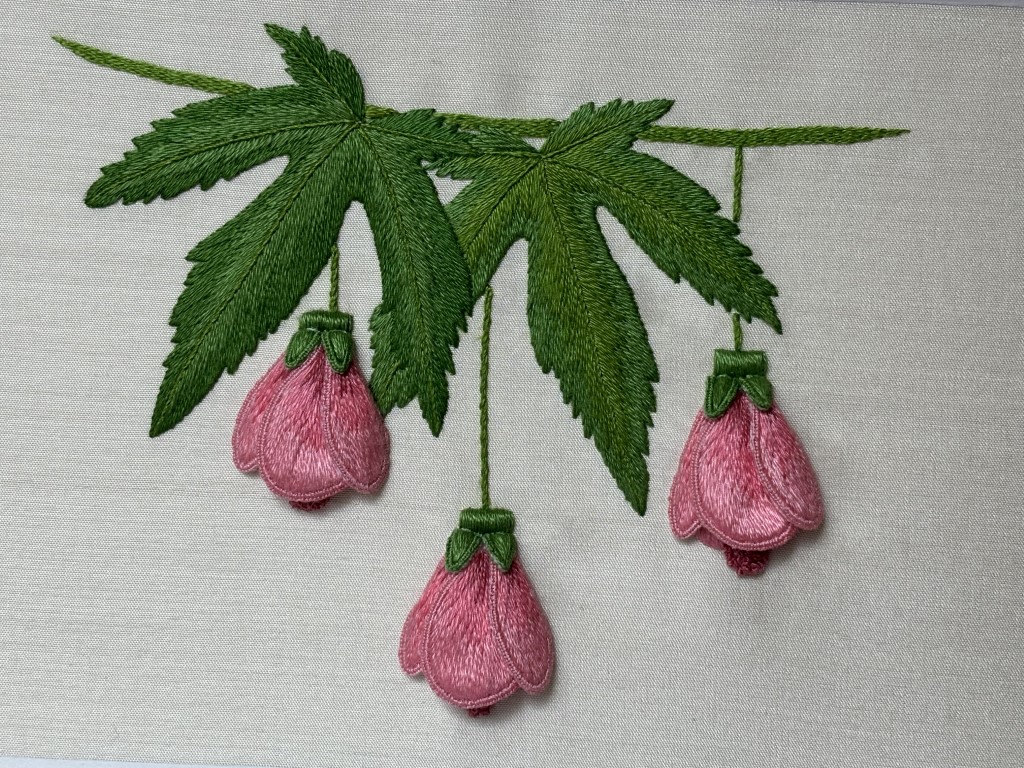Technique: Stumpwork
Place of Origin: England
Earliest known date: 1650-1700
History: The roots of Stumpwork embroidery trace back to the 17th century in England, during the reign of King Charles I. This intricate form, originally known as “raised embroidery” (also called ‘embosted’) gained popularity among wealthy young women, who often showcased their needlework skills in decorative household items and personal keepsakes.
Stumpwork embroidery flourished during the English Renaissance, a period marked by lavish art and decor. Stumpwork was a sign of luxury. Wealthy families commissioned Stumpwork pieces to adorn boxes, gloves, cushions, mirror and picture frames, caskets, and even book covers (in this case, a casket refers to a small, ornamental box covered with naturalistic scenes and motifs). These projects were often embroidered by young women of the household, who were taught needlecraft as part of their domestic education.

Materials, Techniques, and Stitches:
Materials: Traditionally, embroiderers used linen or silk fabric as the base, with padding materials like wool, cotton, or other materials to create raised elements.
Modern Stumpwork often includes contemporary materials like synthetic padding, modern embroidery hoops, and even found objects to achieve unique effects. Threads used in Stumpwork are usually cotton floss, silk thread, or metallic thread, chosen for their ability to add shine and detail to the design.

Techniques: Stumpwork embroidery relies on a combination of padding, wiring, and layering to create its signature three-dimensional realism. Embroiderers stitch onto wired frames to outline specific shapes such as petals, leaves, or wings, which can then be cut out, padded with wool, cotton, or another material, and then sewn back onto a base fabric, creating a sculptural effect.
These wired elements create the illusion of movement and imbue embroidery with enhanced dimension. Beads, spangles, pearls, glass embellishments and metallic threads add additional dimension, texture, and sparkle. With the inclusion of these additional materials, Stumpwork often incorporates embroidery techniques like goldwork, beadwork, and needlelace.

Modern Stumpwork often includes contemporary materials like synthetic padding, modern embroidery hoops, and even found objects to achieve unique effects. Threads used in Stumpwork are usually cotton floss, silk thread, or metallic thread, chosen for their ability to add shine and detail to the design.
Stitches: Stumpwork employs a variety of stitches, many of which are familiar to traditional surface embroiderers. Part of the allure of Stumpwork is that it invites all types of surface embroidery stitches. Satin stitch, stem stitch, and long and short stitch are commonly used to fill shapes and create texture.

One of the distinguishing techniques in Stumpwork is the use of detached stitches, such as detached buttonhole stitch. These are stitched over a framework, often made of wire, to form free-standing shapes. French knots and bullion knots add high-relief details, perfect for creating elements like flower centers or animal and insect bodies.

Padding techniques, such as layering felt or stitching over padded areas, elevate the work (literally and figuratively). All of Stumpwork’s techniques combined create embroidery with great depth and realism.

Motifs: The motifs featured in Stumpwork were dictated by the time periods in which Stumpwork flourished. During the 17th century, Stumpwork designs were heavily influenced by Baroque art, featuring flora, fauna, fruit, butterflies, and biblical motifs. The figures of King Charles and Queen Catherine were also common at the time. In the later Victorian era, Stumpwork experienced a revival with an emphasis on naturalistic and floral motifs.

During the late 18th century, Stumpwork rose in popularity in France, appearing in women’s clothing. Today, Stumpwork has experienced a resurgence in the embroidery community, thanks to a growing appreciation for its complexity and impact. Modern embroiderers blend traditional and contemporary motifs, using new materials and techniques to expand its creative possibilities.

Stumpwork. (2023, February 14). In Wikipedia. https://en.wikipedia.org/wiki/Stumpwork
Embroiderers’ Guild of America (n.d.). 5 Things to Know About Stumpwork Embroidery. EGA. Retrieved November 22, 2024, from https://egausa.org/5-things-to-know-about-stumpwork-embroidery/
Royal School of Needlework (n.d.). Stumpwork. Retrieved November 22, 2024, from https://rsnstitchbank.org/technique/stumpwork
Needlework Tips & Techniques (n.d.). Stumpwork. Retrieved November 22, 2024, from https://www.needlework-tips-and-techniques.com/stumpwork-embroidery.html
Chloe Savage Embroidery (n.d.). Stumpwork Embroidery. Retrieved November 22, 2024, from https://www.chloesavageembroidery.com/stumpwork-embroidery/
Edmonton Needlecraft Guild (n.d.). Stumpwork. ENG. Retrieved November 22, 2024, from https://www.edmontonneedlecraftguild.org/info/stumpwork
Textile Research Centre (n.d.). Stumpwork. TRC Leiden. Retrieved November 22, 2024, from https://trc-leiden.nl/trc-needles/regional-traditions/europe-and-north-america/embroideries/stumpwork









